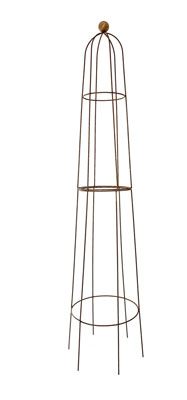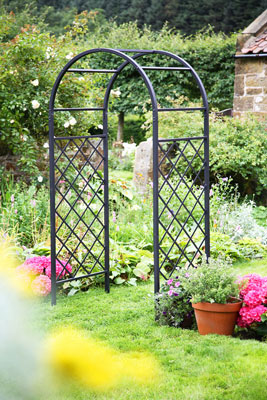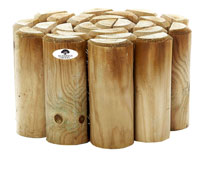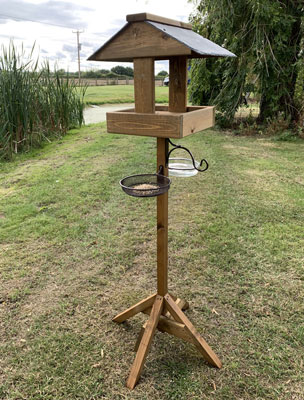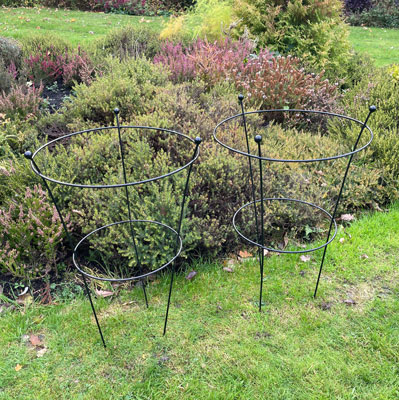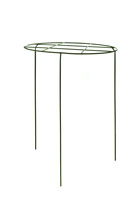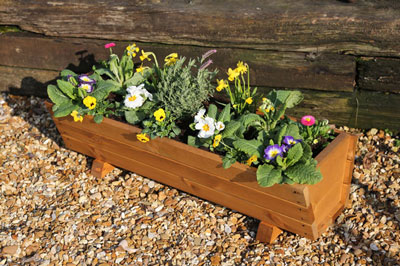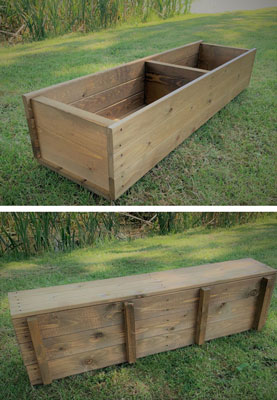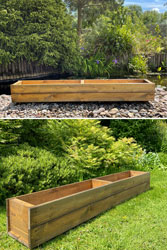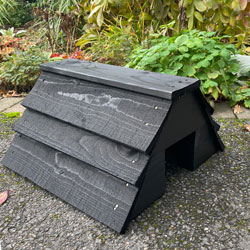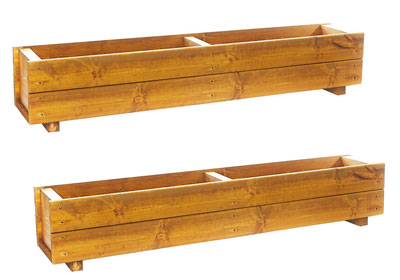Gardening Diaries
November Gardening
November 27th 2016
As we approach December the temperature has dropped and the hours of daylight are significantly fewer, even assuming that the cloud cover has not made an early evening at midday. There are not too many jobs to do outside at this time of year, but a few checks will prevent tears later. Check that your winter protection is still in place, fleece or wind breaks, and packing for tender plants. All pots of tender plants should be in the greenhouse by now, but if you have planted some tender plants out into the garden, then a straw package will help them get through the cold months. Place a chicken wire tube around the plant, and carefully pack with dry clean straw, taking care not to damage the leaves. An outer layer of bubble wrap will keep the straw dry, and prevent it from blowing away.
Outdoor taps should be lagged to prevent bursts, and any exposed pipework in cold buildings also require a covering. Ponds also require some protection, to prevent freezing. If a covering of ice should form, you should not break it by hitting it, as the shock waves can kill water creatures. In stead, a floating item such as a decoy duck can be lifted out, leaving a gap allowing air to be absorbed, and any gases released by plants can escape.
A final harvest of leeks, parsnips, winter cabbage, sprouts and any remaining root crops such as carrots will clear the vegetable beds allowing them to rest before spring.
Houseplants should by now be on a reduced regime of watering, so they do not rot off. You should also check that any heaters in the greenhouse are in working condition.
A considerably less arduous job is the planning of the garden for next year, and ordering any seeds you require. Some vegetable seeds will need to be planted in early January, so organising your thoughts now will make your spring tasks easier.
May Gardening
Lawn which needed cutting, and beds which needed weeding. Par for the course at this time of year. The truly amazing aspect of it all is that we have just enjoyed two days of wonderful weather, most unusual for Spring Bank holiday weekend. So much of the work has been completed in good time. The heather bed is really filling out now, with the small plants we planted last year growing rapidly, and trying to join up together, which was the plan to create clumps of like plants. The most tedious chore at present is tidying up the edges of the beds, trimming the grass back to make a neat separation between grass and bed. This is made more tricky as the daffodil leaves are still in place, and are flopping over and looking quite untidy. However, They are beginning to die back, so I shall soon be able to pull them out. The New par of the long border is filling up, and we shall soon have to decide which camellias and azaleas we want to put in.
The front garden, which has a mostly red theme, is looking good as the red flowered hawthorn is flowering well, as is the deep red weigela next to it. A red geum, which last year had about four flowers, has about ten this year. Many of the geraniums are also progressing well this year, and some are flowering for the first time. This really is my favourite time of year.
May 22nd 2016
It has been a busy week, as the weather has been marvellous. The soil in the vegetable plots has dried out sufficiently to allow many rotovates, and the quality of the soil is wonderful, after many applications of manure and compost over the years. The bamboo clump I stripped out a week or so ago provided enough canes to build a support for climbing beans, runner and French. The canes were fastened together in fours, making a pyramid, then a top cross bar was fastened in, making a sturdy double row. The beans had been planted in the greenhouse a couple of months ago, so were ready for planting out after a few days of hardening off. The trick now is to encourage the plants to twine round the canes, after which they will grow away needing only regular watering if the forecast hot summer does materialise.
I have been busy weeding the long border, and tidying up the edge. There are a couple of plants which are so vigorous that they are becoming a nuisance. Woodruff is one; it seems to be very happy in our soil and climate, and has colonised one end of the long border, but does not recognise the division between bed and lawn. It has jumped, and is flowering freely along with the daisies. We do not mind some daisies in the lawn, but the woodruff is not the right sort of plant for the lawn. It is, however, stunning under a spirea and in front of several hebes.
The front garden looks smart with its new top dressing of bark, but the blackbirds are enthusiastically spreading it everywhere, on the drive, on the road, and on the path which runs through the garden. This path was initially covered with red bark, through a garden with a strong red theme. However, it seems that blackbirds are colour blind, or have different style tendencies, as the red and the natural are thoroughly mixed after only a couple of days. The red flowered hawthorn has lots of buds this year, which is wonderful, considering that when it was planted it was a whip, with little evidence of intent to survive. Now it is a small tree about eight feet high, and with a spread of about five feet.
February Gardening
February 7th 2016
Our batteries are fully recharged after a week away in sunnier climes. We chose Sardinia for our winter break, as we have not been before, and we have a long lost friend who lives in the north of the island. A meeting was arranged for halfway through our stay, so we had two and a half days to explore Cagliari, the capital, and a very ancient city. As we tend to walk or to use public transport during our city breaks, we armed ourselves with a street map of the central areas, and set off to discover the Orto Botanico, the botanical gardens attached to the University of Cagliari. The gardens extend to about five hectares, and were opened in 1866. The major emphasis is on plants from Mediterranean regions, but there is also a significant collection of succulents. There are several greenhouses, some for propagation, and some for protection. There is also a large area dedicated to the major collection of palms, but this part was unfortunately closed to the public on the day we visited, for maintenance. However, even without being able to visit this large part of the gardens, we found plenty to interest us. The garden area has also a considerable archaeological importance because of the presence of tanks and wells from the Roman period. In a land where the collection and storage of water is a major concern, the presence of a permanent water supply is a very valuable asset. One such bubbles up into a large pond adorned by a model of the original roman water wheel, with clay amphora being the means of scooping up the water. The water then falls over a perfectly level stone wall, into a series of ever lower ponds, adding the sound of water to the other effects of the garden. As we were there in January, the temperatures were not excessive, but we can well imagine that in July and August the sound effects will help create a cooling atmosphere. All in all, while these gardens are not the most spectacular we have visited, they were most enjoyable, representing the local area’s flora.
January Gardening
January 24th 2016
The water is slowly but steadily receding from our garden. The land which has been covered is somewhat muddy, but at least some of the plants which have been covered for so long, have managed to survive. Bulbs are showing through, and some of the hardy geraniums in the shade beds are showing green. If they have survived three weeks of being under water, they really do deserve the appellation of hardy. We are still trying to keep off the grass, as it is obviously still very wet, and easily damaged. The blackbirds are digging around, finding plenty to eat in the newly exposed ground. However, the little birds are feeding greedily at the feeding station every minute they can during the day. A frequent visitor to the bird table is a woodpecker, which seems to be very fond of fat balls. Pigeons, doves and pheasants are also to be seen most of the day, and moorhens and mallard ducks are enjoying the extended pond.
We have been busy ordering vegetable seeds this past week, but I have not ordered any flower seeds, as I want to wait till the beds all emerge from the water, and I can tell what needs to be replaced. I hope the bergenia and geraniums are still viable, as well as the astilbe. One plant which seems to be indestructible is the polyanthus. One plant with pale yellow flowers, sold as a primrose, but certainly not like the wild ones, started flowering a couple of weeks before Christmas. It has been sitting in the middle of the water, with about four inches depth covering the leaves, but the flower spires towered over everything, and is still flowering strongly. It is a truly brave plant
December Gardening
So here we are at the end of year. My year went pretty quickly, especially the latter part. This is the time to start looking forward. The shortest day has passed, and days will be getting longer, with gradually lighter mornings and evenings. Although we possible have two months of winter still ahead, signs of spring will steadily begin appearing. Quite often at this time of year the first snowdrops are peeping through, and winter aconites will soon be growing their distinctive ruffs of foliage before the brilliant yellow flowers burst through to cheer an otherwise quiet time in the garden. Hazel catkins will be thinking about plumping up as well.
There are still several jobs which can be done at this time of year. If you have a heated greenhouse, check that the heaters are working well. While insulating your greenhouse will help maintain temperatures above freezing, if you use oil or paraffin heaters, remember that ventilation is essential. If you have apple or pear trees growing out in the open, now is the time to prune them. Start by removing crossing, rubbing, weak, damaged and dying branches. On older trees such as ours are, you should remove or thin out any spur systems that have become congested. The ideal is an open crown so light and air can get in without too much trouble. Where thinning or removal is required, remove spurs on the underside of the branches, where the developing fruit will not receive enough light, and produces inferior fruit. Our trees were neglected for so many years, we are having to sort them out in small, gradual steps, so as not to shock the trees too much.
There are many vegetables which happily over winter out in the garden, so you can harvest them as and when you require them. Brussels sprouts, Savoy cabbages, kale and leeks, can tolerate winter conditions, and as discussed previously, so can parsnips, which improve in flavour when subjected to frosts.
Houseplants should be given a rest now, by gradually reducing watering until the compost is almost dry between watering and stop feeding, except where plants are growing vigorously or flowering.
December 13th 2015
The weather has to be the most talked-about subject of the month so far, with all the troubles in the wake of Storm Desmond. Such a friendly sounding name, yet what devastation it brought with it. We are nowhere near the floods of the northwest of the country, but even our garden has up to a couple of inches of standing water which cannot soak through the already sodden heavy clay. We hear so much about the homes and businesses which have been inundated, and the damage caused. I also think about the gardens, which owners will have tended lovingly, and now will be smothered in sludgy mud and debris. I know that a garden is not as important as a home, but there will be a lot of heartbreak as a result of the destruction.
In our own garden, there is still a surprising amount of activity. My sister-in-law said last week that her snowdrops are in flower already, so I went to look at ours. They are being a little more prudent, with only a small tip showing through the soil, but they are usually ready to flower shortly after Christmas, and this year will be no different. There is also a lovely showing of flowers on both the winter jasmine and the viburnum bodnantense, a lovely scented shrub which brings cheer through the winter months. Other flowering stalwarts are the polyanthus. We have a mixture of colours, having raised them from seed several years ago, and one plant has the most glorious deep blue blooms, which, purely by chance, are sitting alongside a bright pink cyclamen, and the combination is so good we are now looking for more of each.
October Gardening
October 16th 2016
Autumn has definitely arrived, although it is still making a slow start. The trees still look mostly green, but the ground is liberally covered with leaves and twigs. I keep spotting the squirrels busy burying acorns in all sorts of places where we decidedly do not want oak trees to grow. There is still plenty of colour in our long border, mostly down to the glowing red of the sedum and the orange of the last of the calendulas. This is the time of year when the varied colours of the foliage show up most distinctly, with golden conifers, silver green and dark green on the shrubs, and the deep red of the cotinus. There is a vast splash of golden yellow from the rubus, which will glow silver after the leaves have fallen. The winter stems are a glorious silver white which stand out so well against the deep green of the nearby hebes. Our neighbour has an acacia tree, which peeps over the top of the boundary hedge. Its leaves are a lovely feathery shape, and are currently turning to gold as well. It is always of interest to me how different trees shut down at different times. A mature medlar tree in the orchard has about half of its branches covered with brown leaves ready to fall, while the other half is still green.
In the middle of our gravel garden is a well established dog rose, which we have left because we love the graceful arches of the stems, the flowers are beautiful, and at this time of year it is laden with hips, which will be eaten by blackbirds and thrushes when the weather becomes colder. It is great fun watching these birds jumping up to try to catch the glossy red hips, as they prefer not to land on the thorns, and who can blame them for that?
October 11th 2015
Apples are in bountiful supply this year, after last year’s dismal harvest. As everyone who has apple trees also has a glut of the fruit, the challenge is on to find a way of not wasting this seemingly endless supply. One nearby household has bagged up their apples in sixes, and put out a table, asking for money for their apples. This would seem to be rather hopeful. We have about ten trees, and this year every one is so laden with fruit that branches are sweeping the ground. I have found some favourite recipes, and a few new ones to try. Traditional apple chutney is a family favourite, and is a very acceptable gift for hostesses when we go visiting. This year I tried a new recipe, courgette and apple chutney, trying also to put our plentiful supply of courgettes to good use. As I only made it a week ago, I cannot yet report on the success of the venture. Another favourite recipe of mine is mint jelly, using apples as the basis, and adding finely chopped mint. It makes a delicious condiment, especially with ham sandwiches or roast game.
We are also about to venture into apple juice production, having visited a juicing stall at a recent food festival. Cider is another plan, although we do still have some from a previous batch, cider not being our favourite tipple. Our hens enjoy the mash left over from the pressing, and if there is too much for them, the compost heap appreciates it too.
October 4th 2015
The wonderfully warm weather continues, and many plants are also continuing to flower, maintaining colour and interest in the long border. Of particular interest to insects are the sedum spectabile. We have several clumps, all providing goodness for bees, hoverflies, wasps, butterflies and other creatures. Marigolds are also still producing many flowers, as are the larkspur.
To the side of our house we have a gravel garden, built around a pre-existing sumach tree. This is now a glorious shade of flame, a showing which will last just until the next strong wind. Some ornamental grasses planted a couple of years ago are putting on a brilliant display now. We plan to get a couple of manageable bamboos for the back of this area, maybe a black stemmed and a golden stemmed one.
It is bonfire time, especially since the trimming of the leylandii hedge. The pile had become mammoth, about 8 feet high, so I cautiously lit one edge, hoping that it had dried out enough to burn slowly, and not to become a conflagration. Fortunately this was the case, but there was so much material that the fire continued for nearly three days, smouldering away under a blanket of green weeds and seeds that we do not want on the compost pile. I removed a barrow load of ash and soil from one part of the fire spot, and after leaving it to cool overnight, this has been added to a couple of beds which will benefit from some roughage. Most of the rubbish has now been burnt, leaving just a small pile to be the start of the next fire.
September Gardening
September 10th 2017
Once again, the land is soaking, with surface water and soggy grass areas. Some paths are just too wet for walking on, as the soil is being compacted and grass is pulled out by the passing of feet.
While digging up some strawberry plants for our visitors to take away we found about a dozen nearly ripe strawberries which neither birds nor mice have found. What a bonus. The blackberry canes are still producing plenty of fruit, and the apples are nearly all ripe by now, so crumbles are being devoured almost daily. The plums are nearly finished by now, but we have noticed that this year there have been fewer wasps than usual. Normally, picking plums is a hazardous occupation.
Our pampas grass plumes are opening up now, and looking so beautifully sleek and silky. The entire clump is many years old, having been in the garden before we moved here, and we have tried several times to reduce it a bit. One year we burnt it, and we were then able to cut out some of the outer plantlets. Sadly, it then looks unsightly for a long time. This year we have cut some of it back, to enable us to walk round it again. Our window for being able to take drastic measures is quite short, as it houses several nests which are in use all spring and much of summer. I suspect we will have to bite the bullet and burn it again. That procedure requires close attention, as there are many trees and shrubs in fairly close proximity. Probably the best time would be in the middle of winter, when there are few leaves on nearby plants. We will also have to choose a day with no wind. Fortunately ti is on a raised bed with vertical walls, so there will not be hedgehogs hibernating in it.
We have been discussing how to progress with our wild meadow, which is looking rather unkempt this year. We saw one at a garden lawn last week, which has been mown already, quite short, and the grass is greening up nicely, with no soggy clumps of festering grass. So we are considering cutting it soon, rather then leaving it till later, as all the grasses have seeded already, so they do not need to be left to lie. This way, the area can make a fresh start next spring.
September 4th 2016
The season really does seem to be racing along now, with some glorious weather bringing on the harvests. Earlier in the year, when runner beans were planted, we were visited by a hare that has a taste for runner bean plantlets. So instead of about ten plants, we ended up with three. However, those three have more than made up for the lack of the others. We have also an area of French beans, so the freezer is bursting at the seams. Another very successful vegetable this year is beetroot. We have a mixed row, with some white, some pink, and some mottled beets, all of which taste delicious. I braised some last week, and served them with a spring onion sauce, which I had made more than an hour ahead of time, so the flavour had really developed well. That was a very popular dish.
The brambles are producing well, and gradually the apples are ripening, so apple and blackberry puddings are becoming frequent occurrences. We inherited a small orchard of mixed apple trees, mostly eating apples or some dual purpose. They ripen at staggered times, so we have a fairly long harvest period. Sadly, they do not keep well, so our attempts to lay some down a year or so ago ended with a sticky mess to be taken to the compost bins.
A series of visitors this summer has seen a reduction in the work done in the garden, but fortunately we were quite well on top of the weed situation so it should not take too long catching up. Dead heading is the currently urgent task to be done, as especially the campanulas need to be trimmed. Many shrubs are having a second flowering, such as weigela and escallonia, although this showing is much reduced from the earlier efforts. Also, lupins which were dead-headed after flowering, are still throwing up small flower spikes. Mostly, though it is a quiet time in our borders as we are only just now building up a collection of late flowering plants such as Gallardia and asters.
September 20th 2015
Tidying up is very much the order of the day now, with an increasing number of signs of the onset of Autumn. Our Sumach tree is putting on a splendid display of colour, and late flowering plants are in their element. Even bedding plants such as annual lobelia are still flowering well, and our herbaceous red lobelia are just starting to flower. A large mass of Monarda are looking very tired, and need to be cut right down, where there is a plentiful supply of new leaves ready for next year.
Dead heading continues to be a necessary task, especially for plants such as lupins, which will produce far too many young plantlets if left to their own devices. This past week, having been dry and warm, has been dedicated to cleaning out a long neglected hedge bottom. One of the original Leylandii hedges, now at a nearly manageable 10 feet high, has provided shelter for a vigorous growth of nettles and docks. Earlier in the year our neighbours cleaned out their side, shaming me into a concerted effort to match their efforts. Sadly, the bottom couple of feet is bare, and the result of clearing all the undergrowth is to expose the bare patches, and to allow each of us to see into the other’s garden. Not a major problem, but quite different from what we are used to. We wait to see what a visiting dog makes of it next week, as there is now no barrier, either visual or physical, between the two gardens at low level. A four strand barbed wire fence will not deter a determined dog.
August Gardening
August 27th 2017
I have just spent quite a long time weeding our gravelled area. When we first acquired our home and garden, we inherited a large area of crazy paving. The owners before last had spent a lot of money and ingenuity of design making a side garden to enjoy. However, in the course of about forty years, tree roots had lifted the paving slabs, making a dangerous area with very uneven parts. Additionally, a boundary hedge of berberis had been neglected for many years, and was about six feet thick and ten feet high. So we decided to completely refurbish the entire area, joining it to the front garden areas. This was part of the reshaping of the whole frontage, completed about four years ago. The berberis came out, not without much effort and pain. Also a sad ash tree which had grown round a barbed wire fence had to go. A circular brick well was retained, and when the crazy paving was removed we discovered a matching brick circle foundation upon which we added a raised bed in which we planted campanulas. Sadly this raised bed is now totally overgrown, and there are at least two sturdy ash saplings which we are struggling to remove completely. It will need a total makeover, probably over winter when all the worthwhile plants can be lifted and sorted.
The original area was edged with new trellis, and we designed a bendy path to meander through. A couple of small shrubs were planted to give reason to the bends in the path. The whole area was then levelled, flattened, and covered with weed suppressing membrane. Two large conifers, a small clump of rhus and a dog rose were left in situ. During the removal of the berberis, we discovered a couple of steps, accessing the lower level via a different route. These were exposed, and a stepping stone path was laid around the well to the steps. Then a covering of gravel was applied, and the whole area looked really good. The crazy paving had allowed so many weeds to grow, that we really enjoyed the clean, weed-free appearance. Gradually, we have planted interesting grasses in small clumps, trying to maintain the clean lines, yet softening the overall effect by planting. However, over the years, a layer of dust and leaf mould has developed, so weed seeds are now able to find sufficient nourishment to grow, so a regular weeding is required to prevent the weeds from getting too well established. Also, some of the grasses set seeds, and as we do not want the clumps to grow too large, many small grass lets need to be removed. So, after a couple of days on my knees, painstakingly removing many small weeds and grasses, we are back to having a clean and tidy gravelled side garden
August 29th 2015
So we reach the end of August. This year does seem to have flown past, probably because we have undertaken a number of projects in the garden, keeping us really busy. The extended long border has proved to have been a valuable addition to the garden, with a fairly long flowering season enhanced by the annuals planted quite early. Although many are still flowering bravely, they are beginning to look a little tired now, and some are ready for serious cutting back. One I want to leave untrimmed is the nigella, as the seed heads are really attractive in their own right, and will be a valuable addition to the bed in winter, when there will be a number of empty spaces until we can fill them with perennials.
Preparations for the rose garden are well under way, but there are still decisions to be made about the extent of it, and whether to absorb one of the vegetable beds which has not been too productive this last couple of years. One possible reason for this is that an oak tree, which was only a small sapling when we first arrived here, is now growing apace, and casting shadow over the bed. It will also be taking up a lot of water from the ground, so the beans and peas have really suffered. Also, the fact that mice seem partial to seeds planted in the ground is not conducive to successful harvesting.
Another of this year’s projects was the latest shade bed, where the silver birch was planted, and an underplanting of mint and lemon balm was mingled with the existing hypericum. This area is looking quite good, although there are several small stumps from unwanted blackthorn saplings, which keep producing more leaves. I am trying to finish them off by keeping the leaves stripped, as it would be impossible to remove the roots from among all the other tree roots, making digging very difficult. This method may take time, but eventually I hope to succeed
July Gardening
July 31st 2016
We are in the full swing of harvesting produce from the vegetable garden right now, with courgettes, beetroot, broad beans and fennel being ready, among others. The salad rows have been giving us tasty fresh leaves for over a month now, while the freezer is filling up with broad beans. Sadly, our pea crop failed, we think that some of our plentiful wildlife ate the young plants before they were able to provide up with tasty peas. The plants had been raised in the greenhouse, and were thriving and healthy when transplanted, but many disappeared within days, and the few which did survive produced only a couple of pods each, having been severely pruned by small teeth. The strawberries are also being taken, despite being netted. A red billed blackbird was spotted yesterday, suggesting that he might be the culprit. This year is the second year of our asparagus bed, and there are lots of very tall flower spikes, so hopefully next year we should be able to start harvesting that delicious vegetable.
A few days without rain has slowed down the weed growth, so we have been able to relax a little on that front. But the ones which we have missed are flowering gaily, such as willow herb, and every trip into the garden involves pulling them up before they start spreading seeds everywhere. A large calendula bed is a golden, orange and yellow, and they also need deadheading, so that the floral display will continue into autumn.
July 17th 2016
At last the weather seems to be acknowledging that it is summer. The season got off to such a slow start, we are still enjoying rhododendron flowers. Other plants are really coming on line now, too; notably the pentstemons and several of the annuals we planted as seeds last year, and allowed to seed after their flowering period. Some years ago we saw a wonderful plant at a garden in Northumberland, and decided we had to have one as well. It was a ligularia, a large leaved plant with mid-summer yellow flowers. These are just beginning to emerge now, adding a striking feature to our front garden. The shade beds have recovered quite well from their prolonged bath during winter and spring, and quite a few seedlings are now emerging, notably aquilegia and geranium. Sadly, we seem to have lost a thriving clump of woodruff, but as we have plenty around the garden, it will be an easy task to transplant some. The ransomes have disappeared, but some bergenia plants which seemed to have drowned has recently emerged. The resilience of some plants is truly amazing.
July 3rd 2016
We have recently returned home after a ten day break on the Isle of Wight. Not surprisingly, after all the rain, the garden was in desperate need of some TLC. The peonies are exceptional this year, but quite a few have collapsed, despite having supporting frames in position. We have several plants with pale pink flowers, and one with a very deep pink, almost red. A combination of the two colours is stunning.
We are expecting some visitors from overseas next week, so we are being very busy tidying up various areas of the garden. A small step, for which we have been waiting for about four years, has made a real difference to the two gravelled areas, which are on slightly different levels. A clean-up of the patio, with missing pointing being replaced, and we feel as though we have a brand new garden. Our tunnel beds have got somewhat out of control. As they are both quite small, with the pergola dividing them, we want the planting to be tidy and fairly low, but some of the plants seem to have been taking steroids, and have become tall and straggly. This would be acceptable in a larger area, so come autumn some of them are going to be relocated in the long border. Lower and more compact plants will take their place.
The vegetable beds are having mixed fortune as well. The salad rows in the raised beds are doing really well, but the climbing beans are a sorry bunch. Out of about twenty planted out, only four remain. Most have been chewed off, most likely by the pigeons, which are real menaces with fresh young growth. Also in the raised beds, the fennel are plumping up pleasingly. This year we must make an effort to harvest them before they get too large and tough.
July 26th 2015
Every so often we go to visit an open garden, partly to admire someone else’s ideas and hard work, partly to get some new ideas for our own garden. Last week we went to visit a nearby open garden, where the majority of the planting and design was inside an old walled garden. This was subdivided into various sections, one of which was a kitchen garden with marvellous specimens of potatoes, cabbages, peas, courgettes etc. Through an arch was the fruit garden. This was where we got our really good idea.
A few years ago we constructed a fruit cage using plastic conduit and netting. Unfortunately, despite our best efforts to pull the netting really taut, and to secure it firmly into the ground, birds still managed to get in. So we have had minimal returns from especially the red current bushes, which fruited really well, but then were stripped bare just as I decided that the fruit was ready for harvesting. And my family loves home made red current jelly at Christmas time.
The fruit bushes at the garden we visited were caged in portable cages, made from small sections of chicken wire fastened onto a timber frame, as many of which as required were fastened together using cable ties. So the cages were totally removable, could be adapted for various locations, and would store tidily when not in use. Furthermore, they would not need to be erected until such time as the fruit was beginning to set, so the area could remain open except for a relatively short period of time.
So, on our return home, we decided the remove our desperately overgrown fruit cage, dispose of some of the canes and bushes planted in there, some of which were dead or dying, some of which had turned feral and had invaded everything else. The idea was formed to create a rose garden, but to retain a few of the bushes, such as red current and dessert gooseberries, over which the aforementioned modular frames could be erected as and when necessary. So that is what we have spent our past few days doing, and a merry time is being had by all. We are currently rained off, so the plans are being formulated ready for the next stage, after the clean up is complete.
July 5th 2015
As I mentioned last week, we decided that we wanted a Dierama or two for our garden, having seen them in several of the gardens we visited. At the last garden visited, with a return home imminent, we did buy two pots of these very attractive plants, each of which will divide into two or three. We also purchased a variegated Lamium for the shade beds. It should spread and form a very useful ground cover, helping to keep down the weeds. I had always intended sourcing one or two, so seeing them on sale at the last garden seemed like an answer to a prayer, as they are not often seen.
One of the gardens was in an L shaped valley with streams and ponds at the bottom. The garden is the dream and passion of one man who has two or three helpers. It extends to 42 acres. When I think of the work involved in our 1½ acres, I shudder at the enormity of the task he has set himself. Another garden was ten acres, about two thirds of which was landscaped grass. Being set in hilly Devon, all the gardens had streams, ponds and cascades. All very picturesque.
We returned to our garden and a week’s worth of weed growth. All mostly sorted now, allowing the annual seedlings space to grow. The temperatures are very high, which the plants enjoy as long as they have enough water. A major storm last night sorted that need, but the grasses in the wildflower meadow are flattened. We shall have to see if they stand up again in time.
June Gardening
What truly wonderful weather we are enjoying at present. Warm, mostly sunny days, and the occasional shower at night to keep the garden going. Young or recently planted plants still need a bit more watering, but the established plants do not need supplementary water. A couple of nights ago there was sufficient rain to refill the water butt again, so a number of fortunate plants and beds are getting untreated rain water. The water butts are a recent installation for us; we have long intended to have a couple, but it was only this spring when we eventually bought one, a very large one which fills from the garage roof.
The vegetable garden is coming on quite well, with broad beans, runner beans and brassicas all growing quickly. The salad leaves were doing well, and we were able to keep up with them for a couple of weeks, but then a few days of not harvesting them resulted in foot high plants, which we have just cut hard back, and fed the tops to the grandchildren’s guinea pigs, which are holidaying with us. So hopefully, tender young leaves will grow again to give us plenty of salad for the summer months.
This seems to be a period of transition, with many of the spring flowering plants finishing, and summer flowering plants beginning to perform. The red flowered hawthorn has been spectacular this year, but the blossom is dying now, while next to it are two weigela shrubs with wonderful dark red flowers taking over the display. Further along the bed is a red geum, which has more than twice as many blooms this year than last. This bed is still quite young so many of the plants are still establishing themselves. However, we left in place two flowering currants, which are not performing at all, so we plan to replace them with new versions with proven track records for large flowers and long seasons. These will hopefully be planted in autumn ready for next spring. Of the four evergreen heuchera we planted, only two have survived, the others succumbing to being drowned in a very wet period, when the drainage conducted too much water onto these poor plants. We will have to find a replacement which can tolerate being very wet at times.
June 28th 2015
Have just spent a few days away, looking at other people’s gardens. We do enjoy visiting gardens, getting lots of ideas to bring into our garden, and generally experiencing garden envy. As our garden is totally flat, any quarry or hillside garden seems like heaven to us. No doubt, if we had to cope with the access issues, a totally flat garden would seem very desirable. It is always interesting to see the different levels of maintenance; we feel guilty when the small willow herb seedlings show their heads in the herbaceous or shrub beds, but when we see them in most other gardens, even the best maintained ones, we feel a lot happier.
It is always interesting when the gardens we visit have similar soil conditions to ours, so we can look for new planting ideas with a hope for the success of the plants, we photograph the plants with their labels, so we can remember both the name and the appearance. Others we have to write down the names, and hope we can remember which picture they refer to. Yesterday we saw a plant we would very much like in our garden, Dierama pulcherrimum or Angels’ Fishing Rods. They are incredibly delicate flowers, hanging from arching grass-like stems, and growing up to 100cm tall. They flower in July and August; the ones we saw were just coming out. A definite must have
June 14th 2015
The weather is continuing to be unpredictable. We have just been to visit our son in Lancashire, where we helped him to lay some turf in his garden. The weather forecast suggested that the day following the turf laying would be rainy for most of the day, which would have been excellent news for the new lawn, but no, it was warm and windy, necessitating the grass being watered. The following day we had planned a visit to an open garden, and were promised a dry day. We awoke to rain, which continued for most of the morning. So when we arrived at the garden, the grassy paths were still wet, which must have dismayed the owners. However, we thoroughly enjoyed our visit, and saw some wonderful rhododendrons and azaleas, as well as many other stunning plants, including a yellow magnolia, which was new to me.
We also called in at a garden centre, where we bought some foxtail lilies, botanical name Eremurus. They are spectacular when planted in large drifts. So plenty were bought, and tomorrow should see them planted out. They are fairly tall, so they will probably go towards the back of the long border.
Before we went, we had continued with the weeding, as at this time of year the weeds grow faster than the plants. I am trying to keep on top of this chore this year, especially the bramble and nettle areas. We have places where these two can grow free, and provide food and shelter for wildlife, but in our flower and shrub beds I am trying to eradicate them. It feels like an endless task. However, I think I am winning, and a few more years should see them beaten.
June 7th 2015
Last year I invested in a pair of edging shears, which I have been using this week to good effect. Not only do they give a tidy finish to the edge of the grass, but this is very nearly the only gardening chore which can be done standing up straight.
The ever working polyanthus are having a brief rest, and this is the time for lifting and dividing them. However, I did notice the next batch of flower buds nestling deep in the plants, so I shall have to get on with them quickly.
We were away for a short while, during which everything grew at an alarming rate. One of the shade beds was blanketed in a layer of cleaver, which in my childhood I knew as goosegrass. It took me about an hour to thoroughly clean the bed, as I also found buttercups and docks as well. However, the intended planting has also done well, with a number of new aquilegia plants growing strongly and many aquilegia seedlings putting in an appearance. We have quite a few different shades, from pale blue through to deep red, and bi-colour. With a reasonably long flowering season, I look forward to these plants being a major player in the shade beds. The rhododendrons are still flowering well, but I anticipate the need to deadhead them in about a week’s time. Peonies are ready to open up, although those in a friend’s garden in the South were already in flower last week. We do seem to be quite a bit behind normal this year, but no doubt everything will even up eventually
April Gardening
With the season now being in full swing, there is a great deal to do in the garden. The grass needs regular cutting, with the blades being gradually lowered to ultimate desired height. When the land was so waterlogged, it was not possible to cut the grass as early as hoped, so it became very untidy and long. However, grass is one of the most forgiving of plants, and soon will be looking really good again. We are not fussy about weeds in our lawns, as being a very rural garden it is not a problem if daisies and ground ivy pop up from time to time. In fact, on the few hours following a cut, we do miss the sprinkling of mauve or white flowers scattered about. None of our garden is pristine, as we are not trying to make a truly formal garden. We try to keep on top of the majority of weeds, and I like to keep the edges trimmed whenever possible, but we also feel that our garden should be a place we can enjoy, as well as a place for work. We are not work-shy, but occasionally it is pleasant to just sit and appreciate our surroundings.
In flower now is an increasing range of plants. Apple, pear and cherry trees are blooming, and the long border is beginning to look really colourful. The Spirea is laden with white blossoms, just as the magnolia stellata is coming to the end of its display time. Two chaenomeles are also flowering, one orange and one deep red. Fritillaries have been wonderful this year, but they also are coming to an end. We leave the seed heads on, and thus we are increasing our stock and range quite rapidly. The rhododendrons are preparing to give us another stunning show, and we have added extra new young rhododendron plants this year.
We have been harvesting our asparagus for a couple of weeks now, and it is truly wonderful being able to feast on such a special delicacy from our own garden. One side effect of having a wildlife friendly garden is that it attracts wildlife, sometimes undesirable species. We have acquired some rabbits, so we have had to fence in the two ground level vegetable beds, as young beans and brassicas are favourite delicacies of the bunnies. The raised beds are high enough to be out of reach, although pigeons can feast on some of our crops.
There are lots of lovely signs of spring everywhere now. Hedgerows are greening up, and the hawthorn and blackthorn blossom are showing well. Celandines are plentiful, no doubt because of the damp weather, and cow parsley is beginning to show on the road verges.
In the garden, there are so many signs of new growth. The pond has a vast raft of frog spawn, as well as emerging leaves from the water lilies. The leaves on the weeping willow are pale yellow, and many of the shrubs are bursting into leaf. Forsythia and kerria japonica are both sporting yellow blossoms, at the same time as the tassels on the garrya eliptica are fading. We have a viburnum planted amidst some neglected cornus, which have grown up to about twelve feet high. The viburnum has responded, and is carrying deep pink blooms high above the cornus, adding a touch of the exotic to an overgrown area.
I am seriously tempted to replant a ceanothus to replace the one we lost several years ago in a severe frost. However, I am not sure the weather pixies will not decide to send us another such frost if I do. The last specimen was thriving for about nine years before being frozen. I do love blue flowered plants, and the bluebells are budding up already. A local copse is full of these wonderful flowers, so each year we try to walk down to see them.
As the garden tries to dry up, we are assessing what has survived. Sadly, a drift of dwarf blue anemones seems to have gone, as they should be in flower by now. Still, we shall have to wait and see if any come on later
April 12th 2015
The three new silver birch trees have been planted, and the ground around them is now filled with the mint, lemon balm and thyme plants removed from the herb bed. We do still have a very productive herb bed, but these above mentioned are too large, having grown over-enthusiastically over the course of the past three or four years. Half the thyme, one quarter of the mint and two small pieces of lemon balm are quite sufficient for our culinary needs. The surplus can now grow to their hearts’ content under the silver birch trees. Meanwhile the space they occupied can be filled with other herbs with which to flavour our meals.
The year before last we planted a red hawthorn, which arrived as a very small weak whip, and spent all last year growing slowly and steadily. I am hoping that this year it will have a few red flowers, but I may have to be patient yet. We had a specimen at our previous garden, and over the course of about 15 years, it grew into a wonderful small tree, about 12 feet high and laden with red blooms. Whether this one can emulate that remains to be seen.
The raised vegetable beds have had some things planted, small strawberry plants which look as though they will do well, but the asparagus crowns seem to have disappeared, quite probably courtesy of our resident squirrels.
The grass is now ready for another cut, as the warm wet weather has induced significant growth. Hopefully the grass paths between the shade beds will also grow, and thicken up, covering the exposed bare patches.
March Gardening
March 22nd 2015
We have been very busy this week, as the weather has been good. The long border has been extended, and some of the curves have been altered to make them more suitable for mowing the grass without having to go over the same bits several times. I have also been cutting the edges of one of the shade beds, using a half moon spade tool, and scarifying the grass paths around the bed. Some parts of the woodland area have collected a lot of leaves as well as twigs, so the grass has turned into moss. Hopefully the scarifying will allow some grass to grow, although the shade is quite deep so ant grass will be sparse.
Lots of plants are growing really well now, with pulmonaria flowering already, and this will continue until well into late summer. Helebores are also flowering well, and the daffodils are showing up brightly everywhere. Several shrubs are producing plentiful buds, promising plenty of blossoms later on. Two in particular are osmanthus and chaenomoles, both of which put on a really stunning show.
I had my first bonfire of the year today; having removed a fruit cage where there was once a raspberry bed, I decided that it would be a good place for a bonfire, rather than burn where maybe hedgehogs are still sheltering. So a good amount of dead wood, brambles and weeds have been disposed of. Many vegetables have been planted by now, some indoors, some in the beds where they are to grow. We shall have to cover some from pigeons and squirrels, or we will not be harvesting much.


